Hylocereeae
The Hylocereeae are a tribe of cacti. Most are found in the tropical forests of Central and northern South America, and are climbers or epiphytes, unlike most cacti. The tribe includes between six and eight genera in different circumscriptions. The plants known as "epiphyllum hybrids" or "epiphyllums", widely grown for their flowers, are hybrids of species within this tribe, particularly Disocactus, Pseudorhipsalis and Selenicereus, less often Epiphyllum, in spite of the common name.[2]
| Hylocereeae | |
|---|---|
_91b.jpg.webp) | |
| Disocactus anguliger | |
| Scientific classification | |
| Kingdom: | Plantae |
| Clade: | Tracheophytes |
| Clade: | Angiosperms |
| Clade: | Eudicots |
| Order: | Caryophyllales |
| Family: | Cactaceae |
| Subfamily: | Cactoideae |
| Tribe: | Hylocereeae Buxbaum[1] |
Description
The members of the tribe are very variable in their morphology, especially when the terrestrial Acanthocereus is included. Many species form aerial roots. The hylocereoid clade (Selenicereus, Weberocereus and probably Aporocactus) are mostly climbing or epiphytic, and have spiny ribbed stems. The phyllocactoid clade (Epiphyllum, Disocactus, Kimnachia and Pseudorhipsalis) are mainly epiphytic, and have spineless flattened leaf-like stems. Flowers and pollination syndromes are equally diverse, ranging from large white nocturnal flowers to bright red flowers opening in the daytime.[3][4]
Taxonomy
The group was first identified by Britton and Rose in 1920 as the subtribe Hylocereinae of the tribe Cereeae (subtribe Hylocereanae of tribe Cereanae in their terminology).[1][5] In 1958, Buxbaum revised the subtribe Hylocereinae, placing it in a newly created tribe Hylocereeae,[1] which included four other subtribes, some containing genera removed from Hylocereinae, others containing different genera.[6]
The International Cactaceae Systematics Group classification, based on Barthlott & Hunt (1993), recognized six genera within the tribe.[4][7] Subsequent studies suggested a number of changes, for example including Acanthocereus in the tribe and excluding Strophocactus (which had been sunk into Selenicereus). It was also shown that Hylocereus was nested within Selenicereus.[8] A major molecular phylogenetic study of the tribe was published in 2017. The lefthand cladogram below shows the relationships obtained (using the authors' circumscriptions of the genera and tribe).[3] A 2020 phylogenetic study, which also included morphological features of the stem, produced the righthand cladogram below. This resolved the position of Aporocactus, placing it within the hyloceroid clade, but left relationships within the phyllocactoid clade unresolved.[9]
|
|
The authors of the 2017 study proposed revised circumscriptions of some of the genera and of the tribe to make them monophyletic according to their molecular phylogeny:[3]
- Acanthocereus, which had been included in Hylocereeae by some earlier authors, but also in Echinocereeae, Pachycereeae and Phyllocacteae, was expanded to include Peniocereus subg. Pseudoacanthocereus, and restored to Hylocereeae.
- Aporocactus was separated again from Disocactus.
- Selenicereus was expanded to include part of Weberocereus and the whole of Hylocereus, which was nested within it. Strophocactus wittii, which had been included in Selenicereus, was excluded from the Hylocereeae altogether, along with the genus Deamia, containing two species that had been placed in either Strophocactus or Selenicereus.
- To maintain the monophyly of Pseudorhipsalis, Pseudorhipsalis ramulosa was moved to a new genus, Kimnachia, as Kimnachia ramulosa.
The table below compares the 1993 and 2017 classifications.
| Barthlott & Hunt (1993)[7][4] | Korotkova et al. (2017)[3] |
|---|---|
| – | Acanthocereus |
| Disocactus | Aporocactus |
| Disocactus | |
| Epiphyllum | Epiphyllum |
| Hylocereus | Selenicereus (excluding Strophocactus and Deamia) |
| Selenicereus | |
| Weberocereus s.l. | |
| Weberocereus s.s. | |
| Pseudorhipsalis | Pseudorhipsalis |
| Kimnachia |
Genera
The tribe Hylocereeae includes eight genera in the 2017 classification by Korotkova et al.[3]
- Acanthocereus (Engelm. ex A.Berger) Britton & Rose (13 species)
- Aporocactus Lem. (2 species)
- Disocactus Lindl. (15 species)
- Epiphyllum Haw. (10 species)
- Kimnachia S.Arias & N.Korotkova (1 species)
- Pseudorhipsalis Britton & Rose (5 species)
- Selenicereus (A.Berger) Britton & Rose (31 species)
- Weberocereus Britton & Rose (6 species)
As of March 2021, the acceptance of some of these genera varied. For example, Plants of the World Online accepted Aporocactus[10] and the sinking of Hylocereus into Selenicereus,[11] but did not accept Kimnachia.[12]
 Acanthocereus tetragonus flower (right), A. subinermis flower and fruit (left)
Acanthocereus tetragonus flower (right), A. subinermis flower and fruit (left)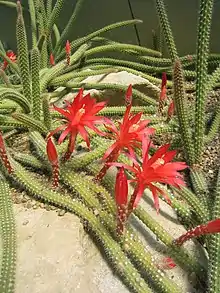
_1.34.jpg.webp) Disocactus biformis
Disocactus biformis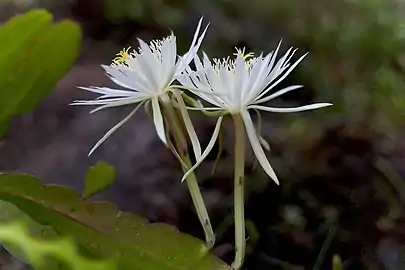
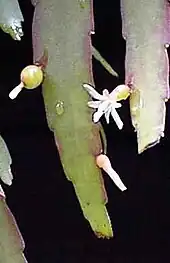
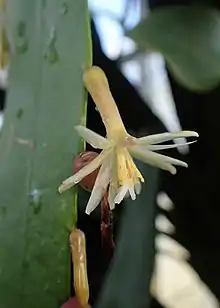 Pseudorhipsalis himantoclada
Pseudorhipsalis himantoclada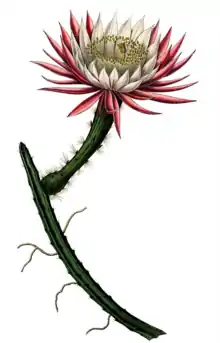
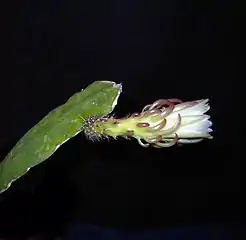
Distribution
Selenicereus is the largest genus in the tribe, and is native from Texas though Central America and the Caribbean into South America as far as Northeast Argentina.[11] Other genera have a more restricted distribution within this area; for example, the two species of Aporocactus are native to Mexico.[10]
References
- Reveal, James L. (2011), Indices Nominum Supragenericorum Plantarum Vascularium – H, retrieved 2021-03-09
- Anderson (2001), p. 286
- Korotkova, Nadja; Borsch, Thomas & Arias, Salvador (2017). "A phylogenetic framework for the Hylocereeae (Cactaceae) and implications for the circumscription of the genera". Phytotaxa. 327 (1): 1–46. doi:10.11646/phytotaxa.327.1.1.
- Anderson, Edward F. (2001), The Cactus Family, Pentland, Oregon: Timber Press, ISBN 978-0-88192-498-5, p. 101
- Britton, N.L. & Rose, J.N. (1920), "Subtribe 2. Hylocereanae", The Cactaceae Vol. 2, Washington, D.C.: The Carnegie Institution, p. 183ff., retrieved 2021-03-09
- Buxbaum, Franz (1958), "The Phylogenetic Division of the Subfamily Cereoideae, Cactaceae", Madroño, 14 (6): 177–206, JSTOR 41422934
- Barthlott, W. & Hunt, D.R. (1993), "Cactaceae", in Kubitzki, K.; Rohwer, J.G. & Bittrich, V. (eds.), Flowering Plants · Dicotyledons. The Families and Genera of Vascular Plants, vol. 2, Berlin: Springer, pp. 161–197, doi:10.1007/978-3-662-02899-5_17
- Korotkova, Borsch & Arias (2017), p. 3
- Martínez-Quezada, Daniel M.; Arias, Salvador; Korotkova, Nadja & Terrazas, Teresa (2020), "The phylogenetic significance of the stem morpho-anatomy in the Hylocereeae (Cactoideae, Cactaceae)", Plant Systematics and Evolution, 306, 8, doi:10.1007/s00606-020-01639-x
- "Aporocactus Lem.", Plants of the World Online, Royal Botanic Gardens, Kew, retrieved 2021-03-07
- "Selenicereus Britton & Rose", Plants of the World Online, Royal Botanic Gardens, Kew, retrieved 2021-03-07
- "Kimnachia S.Arias & N.Korotkova", Plants of the World Online, Royal Botanic Gardens, Kew, retrieved 2021-03-07
External links
 Media related to Hylocereeae at Wikimedia Commons
Media related to Hylocereeae at Wikimedia Commons Data related to Hylocereeae at Wikispecies
Data related to Hylocereeae at Wikispecies- www.epiphyllums.org